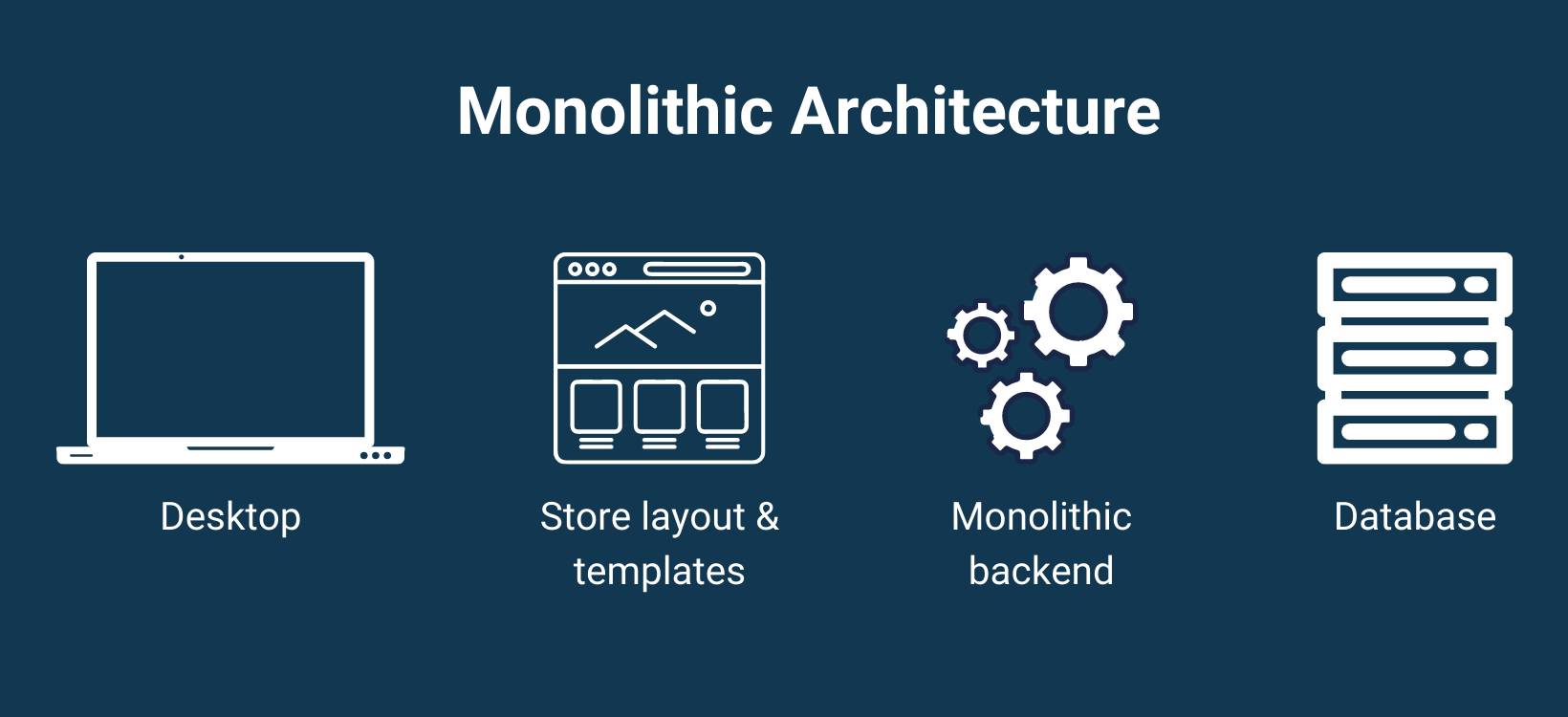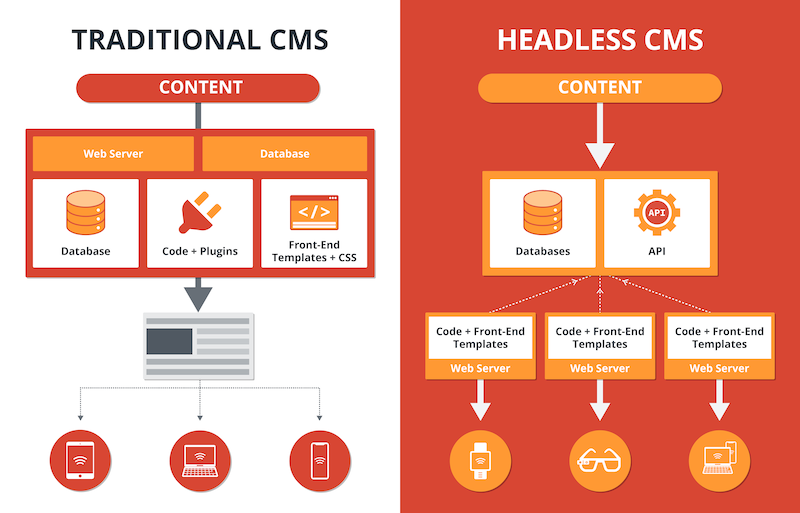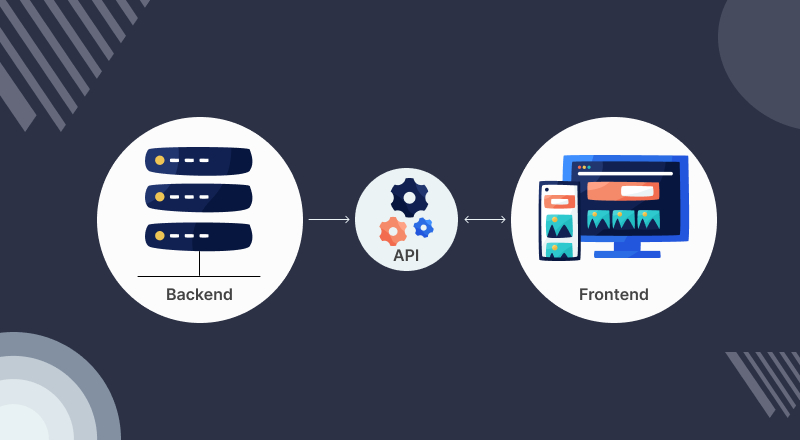Your cart is currently empty!
Headless Magento: Introduction and why ReactJS is perfectly suited for it?
If you are using Magento, you might have heard about headless Magento. It is a type of web architecture that represents the separation of a site’s frontend and backend. Online merchants are already making active investments in such a shift.
When combined with ReactJS, Headless Magento offers an app that gives a consistent and well-rounded experience for the client, similar to PWAs and Customized Web Apps.
In this post, we’ll discuss deeply Headless Magento as well as the reason why React JS is considered the perfect solution for it.
Headless Magento: An overview
Magento has historically been a monolithic platform, which implies that the backend and frontend are tightly connected like bricks and cement.
Monolithic Architecture

This architecture has resulted in a number of serious concerns throughout time:
1. Running slow on mobile devices
- Because the front end is always created on the backend. This is the basic operating premise of all monolithic sites.
- These kinds of online shops are constantly in need of Magento mobile optimization. But, “therapeutic” measures may not lead to huge increases in the speed of current gadgets.
2. Low buyer mobile experiences
Most stores still do not offer separate frontends for different devices. Even smartphones are affected. Then your clients may confront a variety of usability issues, such as:
- On the main and product pages, the header may take up too much space.
- The above-the-fold region of a product page shows very little information about an item: a consumer just sees a photo (not even entirely). There is no name, no price, no rating, and no “Add to basket” button (as shown on Ikea’s website). As a result, consumers are forced to scroll down rather than receive the required facts right away.
3. Routine maintenance, customization, and scaling are becoming more difficult
- You’d like to display a wish list button or add any other new feature to the user interface.
- You simply want to alter the location of blocks on the product page.
- Developers need to edit the backend code to make any layout changes.
- As a side effect, the code itself is bloating.
4. Strategic development is also restricted
New products on the market (smartwatches, TVs, voice assistants, and so on) represent potential touchpoints to cover online shops. You might be able to find suitable crafting frontends for each of them in the foreseeable future. With the monolithic method, it is conceivable but highly difficult to keep a few “heads”:
- Your website grows more complicated with each additional frontend (for phones, then new channels) added to the backend coding. It will be more difficult to divide it all in the future.
- Changes or errors in one section of this single codebase may have an impact on other portions of your store.
- The technique given is out of date. Meanwhile, contemporary technologies (for example, a progressive framework like React JS) aid in the creation of frontends and provide your clients with a pleasant UX/UI.
Headless Architecture
The headless architecture, on the other hand, makes use of the Magento backend as a Content Management System. Meanwhile, the front end is divorced from Magento to allow for greater customization that is not limited to the platform.
To understand how a headless Magento shop varies from a regular one, it’s critical to first grasp the vital distinctions between headless ecommerce and monolithic architecture.
Headless vs Monolithic Architecture: Comparison
Everything operates in a cohesive block for the old technique, and one modification affects another. Frontends are frequently responsive. This implies that there is just one frontend design for each backend, and this design is designed to be partly presented on different screen sizes to maximize UI and UX.
Meanwhile, with the headless method, the backend and frontend are separated by utilizing an API as a bridge. You can link one backend to many frontends and vice versa. While your company continues to reap the benefits of all of Magento’s e-commerce capabilities. A headless system allows for rapid and effective creative control over customer interactions. A lot has changed in the world of e-commerce; shoppers now want a smooth buying experience on a speedy and easy-to-use website.

Headless Magento
Magento is a PHP-based e-commerce platform that produces unique web storefronts and is used by many developers worldwide. It is a great choice for the backend of a headless build, whether through a distinct framework or a headless CMS. The main caution is that not every Magento feature has fully developed APIs (like with an API-first platform or some of the more headless-focused systems), which may necessitate additional development effort. Magento’s page builder, as well as content staging and preview, are notable instances of such functionalities.
This, along with the other development overheads, are the only arguments against going headless with Magento. But many people have countered this and have created extra features or begun merging other solutions to improve affected areas.
Why Headless Magento is important?
The Headless Magento strategy boosted flexibility, performance, and the ability to personalize content, resulting in a better user experience for consumers.
Magento has a distinct design, which implies that the interface and backend are inextricably linked. Because the front end and back end are decoupled, you can build and manage the front end without depending on the backend. Thus, you may change the front-end theme of Magento without impacting the backend.
What does Headless Magento offer merchants?
Magento and headless architecture complement one other tightly. While the open-source nature of Magento allows the headless architecture to realize its full potential, a headless CMS compensates for Magento’s lengthy development time.
Here are what you receive when turning your Magento store into the headless Magento:
1. Improved omnichannel experience
Headless allows you to grow to additional channels in a more consistent manner. You can try out new markets for your items. It is not restricted to websites, mobile devices, and tablets, but also offers new chances for unusual devices such as Billboard, Apple Watch, IoT devices, and so on. The greatest benefit of a headless CMS is content unification. To post content to your browser site, mobile applications, and other devices, you used to need to use various admin dashboards. All displays in the headless method are linked to the Magento CMS. As a result, the material can be uploaded rapidly, with a single uniform branding message transmitted across all devices.
Furthermore, frontends for conventional retailers are frequently responsive, which implies that one design is used for several screens. With headless technology, you can create distinct frontends for mobile, desktop, and other display devices, optimizing the best experience for each device.
2. More flexible customization
Customization and maintenance of an open-source platform like Magento necessitate significant development work. Unintentional changes might result in defects and mistakes. However, once the backend and frontend are decoupled, it is simpler to make changes to the frontend without impacting the backend, and vice versa.
Coders may simply test new features and add new technologies to the frontend without having to worry about what is going on in the backend. Furthermore, various team groups may operate on different portions of the Magento website at the same time without any problems.
3. Create storefronts with freedom

Traditional Magento stores rely on preset themes for storefront design.
For headless frontends, on the other hand, it is free to construct unique UI & UX designs based on any suitable frameworks or programming languages. While the approach takes some time to start, once the foundation is in place, developers may quickly adjust the front end without regard to these limitations.
Using a page builder tool for headless frontends is also a good option. Store owners can quickly drag and drop storefronts, add a button, or change layouts in minutes without requiring any code.
4. Better localization and personalization
The content hierarchy in Magento allows shop owners to construct several websites and storefronts for distinct consumer groups, which is a wonderful place to start with personalized marketing. Personalization is taken to the next level with a headless Magento website, which improves development speed, content unification, and frontend flexibility.
Developers can construct stores for different nation segments more quickly, and marketing teams can produce content more quickly. Furthermore, the frontend(s) may be effortlessly integrated with AI and machine learning. As a result, you may collect user data and give highly tailored texts and visualizations.
As a result, many worldwide businesses pursue thorough localization as part of their strategy for growing into new markets.
5. Greater speed
When frontends and backends are divided, they become lighter and hence load quicker. Further, because customization is more versatile, developers may find it easier to improve site speed for a headless Magento site.
Also, headless commerce and Progressive Web App (PWA) frequently coexist. PWA stores often replace the previous frontend and link to a Magento backend to improve speed. PWA employs Service Worker technology for device-level caching, which may increase page performance by two to four times.
On the other hand, there are some inevitable drawbacks that users have to deal with:
6. More development efforts requirement
Creating a headless Magento site is more difficult than creating a regular store. It necessitates the development of unique themes, APIs, and even custom functionality.
As a result, maintaining a headless Magento shop requires more effort. It necessitates the usage of a skilled in-house development team; otherwise, you must rely on a Magento firm to keep your website running properly.
7. Time-to-market problems
A headless store typically takes longer to launch due to the quantity of customization work and the high technical level needed.
While developers may finish a Magento website in one month, a basic headless Magento shop takes roughly two months to complete before deployment.
8. Pricing issues
Harder effort and longer project hours invariably result in greater expenses. As a result, headless architecture is becoming increasingly popular among corporate firms.
Merchants going headless must carefully consider the sorts of customization and technology required to ensure that development does not exceed the budget.
When combined with ReactJS, Headless Magento offers an app that gives a consistent and well-rounded experience for the client, similar to Progressive Web Apps (PWAs) and Customized Web Applications.
A deep dive into ReactJS
What is ReactJS?

ReactJS is a javascript library for building user interfaces. This framework helps you to design adaptable user interfaces. React is a framework for creating dynamic user interfaces. It facilitates the creation of scalable user interface components that show data that changes over time. One of the most important advantages of ReactJS is the ability to reuse components. Developers save time since they do not have to write many programs for the same functionality.
Why ReactJS is the optimal choice for Headless Magento?
ReactJS is an excellent choice for an e-commerce platform, such as Headless Magento, for website creation, as it has its own large Magento Community.
Here are some of the merits when using ReactJS for headless Magento:
- Creating a frontend with React code is straightforward.
- React guarantees that your code works smoothly and that it is simple to maintain.
- React is simple to use.
- Its architecture provides for speedy page loading, rendering, responsiveness, and user-friendliness.
- The bulk of SEO-related issues is covered.
How to apply ReactJS in Headless Magento?
When it comes to integrating ReactJS in Magento development, there are numerous choices to consider. The decision is based on the preferences and skills of the developer you will employ for the development.
Applying ReactJS
You can simply integrate ReactJS in Magento by utilizing only ReactJS; it is one of the top frameworks with the highest star on GitHub. To use ReactJS in Magento, you must build modules from the ground up rather than tweaking pre-made templates.
PWA Studio
The PWA Studio is a Magento project that allows you to create Progressive Web Apps (PWAs). It provides a collection of items and designs that must be created for the Magento React shop.
A Progressive Web Program (PWA) is a browser-based software application that functions similarly to a cloud-delivered native application. It is built on the Web platform and operates in a browser.
Wrapping up
After all, we have already learned about Headless Magento as well as why ReactJS is the ideal choice for headless Magento. It is really vital in the construction of progressive online apps and headless Magento.
If you are interested in Headless Magento, we – Magesolution are willing to help you. We are proud to say that we can provide the best Magento PWA solutions, which can help your business develop professional PWAs. If you have any questions or concerns, please CONTACT US as soon as possible.



